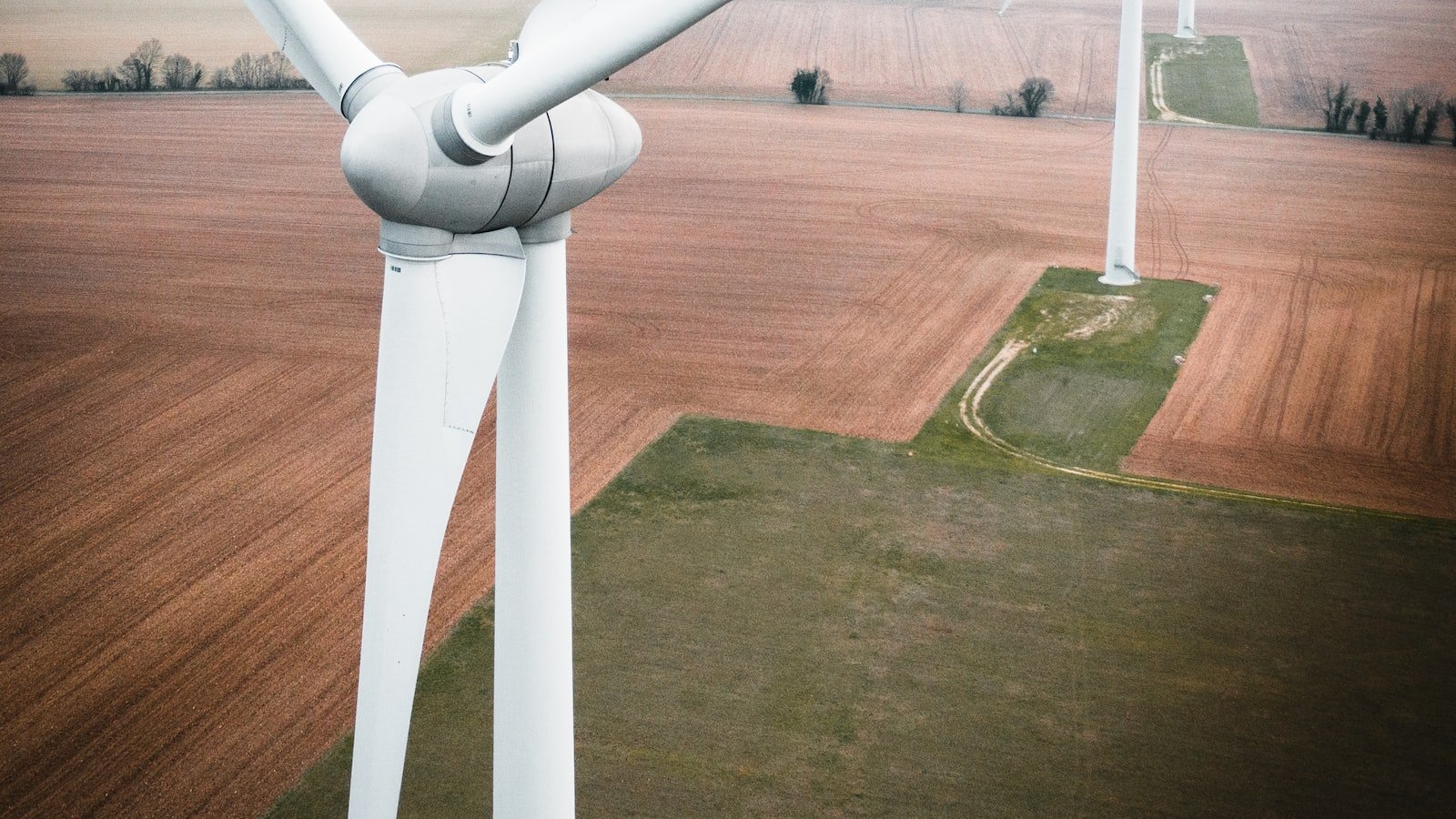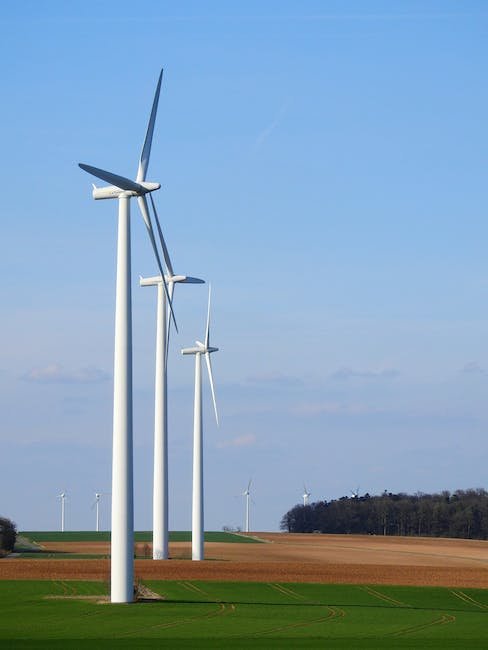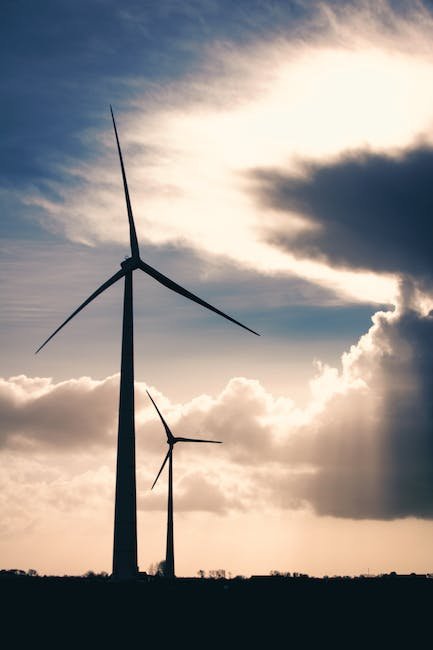Imagine harnessing the invisible force of the wind, transforming it into a powerful ally for your buzzing beekeeping operations. Picture endless fields of vibrant flowers, soaked in sunlight and swaying gracefully under a gentle breeze. While the sun offers its radiant energy during the day, the wind provides an opportunity to further boost your apiary’s sustainability and productivity. With wind energy, you can embrace a greener path for your beekeeping endeavors, reducing your ecological footprint and embracing the harmonious dance between nature and agriculture. Delve into this enlightening guide to unlock the secrets of utilizing wind energy, enabling your beehives to thrive while nurturing the environment that sustains them. Get ready to soar to new heights and embrace the whispers of the wind, as we uncover the fascinating realm of wind-powered beekeeping.
Table of Contents
- Harnessing the Power of Wind Energy: A Sustainable Solution for Beekeeping Operations
- Exploring the Advantages and Challenges of Wind-Powered Beekeeping Systems
- Selecting and Installing the Perfect Wind Turbine for Your Apiary
- Optimizing Wind Energy Efficiency: Tips for Beekeepers
- Maximizing the Benefits of Wind Energy in Beekeeping: Best Practices and Innovations
- Q&A
- In Summary

Harnessing the Power of Wind Energy: A Sustainable Solution for Beekeeping Operations
Wind energy has emerged as a remarkable solution for sustainable beekeeping operations, revolutionizing the way honey is produced. With the power of wind, beekeepers can now harness clean and renewable energy to power their apiaries, reducing their reliance on traditional energy sources and minimizing their carbon footprint.
By installing wind turbines near their bee yards, beekeepers can generate electricity to operate various equipment essential for maintaining hive health, such as honey extractors, wax melters, and temperature-controlled storage units. This renewable energy source not only reduces operating costs but also promotes environmental preservation, exemplifying the harmonious coexistence between beekeeping and sustainable practices.
Moreover, wind-powered irrigation systems are instrumental in providing bees with a constant supply of water, ensuring their hydration and overall well-being. With the ability to pump water from nearby sources directly into designated bee watering stations, this innovative solution safeguards the delicate balance of ecosystems while optimizing bee productivity. Embracing wind energy in beekeeping operations is not only a step towards a greener future but also a distinct way to support and enhance the vital role that bees play in our ecosystems.
Exploring the Advantages and Challenges of Wind-Powered Beekeeping Systems
When it comes to sustainable beekeeping practices, harnessing the power of wind has emerged as a promising and innovative solution. Wind-powered beekeeping systems offer several unique advantages that traditional methods lack. Firstly, these systems provide a green and renewable source of energy, reducing dependence on fossil fuels and minimizing carbon emissions. This environmentally-friendly approach aligns perfectly with the growing global trend towards sustainability.
Furthermore, wind-powered beekeeping systems offer increased flexibility and independence to beekeepers. By harnessing the wind’s energy, beekeepers are not constrained to specific locations with readily available power sources. They can set up their hives in diverse and geographically remote areas, enabling them to access untouched floral resources, thus enhancing the quality and variety of honey produced. This flexibility also allows beekeepers to optimize hive placement, maximizing sun exposure and shelter from harsh weather conditions.
However, it is important to recognize the challenges associated with wind-powered beekeeping systems. Although wind turbines can provide a consistent and reliable source of energy, they require careful planning and maintenance. Beekeepers must ensure that the turbines are strategically positioned to avoid disrupting the natural flight paths of the bees. Additionally, wind-powered systems may not be suitable for areas with lower wind speeds, limiting their applicability. Overcoming these challenges is crucial to fully capitalize on the potential of wind-powered beekeeping systems.

Selecting and Installing the Perfect Wind Turbine for Your Apiary
Harnessing the power of wind energy can greatly benefit your apiary and help promote sustainability. When selecting and installing a wind turbine for your apiary, it’s important to consider several factors to ensure you choose the perfect one that meets your needs.
The Ideal Wind Turbine Features:
- Size: Consider the size of your apiary and available space when selecting a wind turbine. Ensure that it is not too large or obstructive to the surrounding environment.
- Power Output: Assess your power requirements. Choose a wind turbine with sufficient power output to effectively supply energy for your apiary operations, including electric fence chargers, honey extraction equipment, and lighting.
- Noise Level: Pay attention to the noise generated by the wind turbine. Opt for models that operate quietly to avoid any disturbances that could stress out your bees.
- Durability: Select a wind turbine that is built to withstand various weather conditions, especially strong winds. This will ensure longevity and minimize the need for frequent maintenance or repairs.
Installation Tips to Optimize Performance:
- Location: Place your wind turbine in an area with maximum exposure to prevailing winds. Avoid obstructions that may disrupt the airflow and reduce its efficiency.
- Height: Install the wind turbine at an optimal height to catch stronger and more consistent winds. Consider elevating it on a tower or pole.
- Maintenance: Regularly inspect and maintain your wind turbine to ensure optimal performance. Periodically lubricate moving parts, clean the blades, and check for any signs of wear or damage.
- Connection: Ensure a safe and reliable electrical connection between the wind turbine and your apiary’s electrical system. Seek professional assistance if needed, to avoid any safety hazards.
By carefully selecting the right wind turbine and providing a proper installation, you can tap into renewable energy while supporting your apiary’s sustainability goals. Follow these guidelines to make a wise decision and enjoy the benefits of eco-friendly power generation for your beekeeping operation.

Optimizing Wind Energy Efficiency: Tips for Beekeepers
When it comes to beekeeping, harnessing wind energy can greatly enhance the efficiency of your operations. By taking advantage of natural airflow, you can create an optimal environment for your buzzing friends. Here are some essential tips for beekeepers looking to optimize wind energy efficiency:
- Strategic Placement: Be mindful of the orientation and placement of your hives. Position them in areas where they can benefit from prevailing winds and avoid excessive exposure to strong gusts. This way, you can maximize the flow of fresh air into the hives, keeping them well-ventilated and maintaining a stable temperature for the bees.
- Utilize Windbreaks: Erect windbreaks, such as hedges or fences, around your beehives to provide protection from harsh wind conditions. These barriers not only shield the colonies but also help maintain a steady airflow, preventing stagnant air from accumulating around the hives.
- Opt for Strategically Designed Hive Components: Consider using hive components with ventilation features, such as screened bottom boards or top ventilation boxes. These additions promote better air circulation within the hives, reducing humidity levels and improving overall bee health.
Remember, optimizing wind energy efficiency in beekeeping not only benefits the bees but also enhances the productivity and longevity of your colonies. By implementing these tips, you can create a well-balanced and harmonious environment, allowing your bees to thrive and produce the golden nectar we so cherish!
Maximizing the Benefits of Wind Energy in Beekeeping: Best Practices and Innovations
In today’s rapidly evolving world, it is essential for beekeepers to stay ahead of the curve and explore innovative methods to optimize their operations. One such avenue worth exploring is the utilization of wind energy within the realm of beekeeping. By harnessing the power of nature’s invisible force, beekeepers have the opportunity to both reduce their environmental footprint and enhance their productivity. Here are some best practices and cutting-edge innovations to maximize the benefits of wind energy in beekeeping:
- Location is key: When setting up your beehives, choose a location that receives a consistent and moderate level of wind. Avoid excessively windy areas, as it could cause stress to the bees and hamper their foraging efforts. Similarly, areas with minimal wind would miss out on the full potential of wind energy utilization.
- Creating wind tunnels: Install windbreakers strategically around your apiary to create wind tunnels that guide air currents towards the hives. This ensures a steady flow of fresh air, preventing heat buildup and reducing the chances of diseases and pests. Additionally, it aids in the dispersal of pheromones, helping the bees communicate effectively.
- Utilizing wind-powered devices: Embrace innovative technologies that harness the power of wind to augment your beekeeping practices. Install small wind turbines near your apiary to generate clean energy for operating equipment and lighting. This sustainable approach not only reduces your reliance on traditional power sources but also minimizes your carbon footprint.
By adopting these best practices and incorporating innovations driven by wind energy, beekeepers can unlock significant benefits, including improved hive health, increased honey production, and reduced operating costs. Let’s tap into the limitless potential of wind to propel the future of sustainable beekeeping.
Q&A
Q: What is wind energy and how can it be used in beekeeping operations?
A: Wind energy refers to the power generated by harnessing wind to produce electricity. In beekeeping, wind turbines can be utilized to generate clean and renewable energy to power various aspects of the operations, such as electric fences, lighting, or even small-scale honey extraction equipment.
Q: How beneficial is wind energy for beekeeping operations?
A: Wind energy offers numerous benefits for beekeeping operations. Not only does it provide a sustainable source of electricity, but it can also help reduce reliance on conventional power sources, lowering costs and minimizing the environmental footprint of the beekeeping activities.
Q: What factors should be considered when implementing wind energy in beekeeping?
A: Several factors should be taken into consideration when incorporating wind energy into beekeeping operations. These include the average wind speed in the area, the suitability of the land for erecting wind turbines, applicable regulations and permits, as well as the potential impact on local wildlife and the visual landscape.
Q: How can wind turbines be used in remote or off-grid beekeeping locations?
A: Wind turbines offer an ideal solution for remote or off-grid beekeeping locations. By capturing the power of the wind, these turbines can generate electricity independently, providing a reliable energy source for essential beekeeping equipment, even in areas where grid connections may not be available.
Q: What are the maintenance requirements for wind turbines used in beekeeping?
A: Regular maintenance is necessary to ensure the efficient and effective use of wind turbines in beekeeping operations. This includes periodic inspections, ensuring proper lubrication, checking for any signs of wear or damage, and promptly addressing issues to optimize their performance and extend their lifespan.
Q: Can wind energy help reduce beekeeping’s impact on the environment?
A: Yes, wind energy can play a crucial role in reducing the environmental impact of beekeeping. By utilizing renewable wind power instead of relying on conventional energy sources, beekeepers can contribute to minimizing greenhouse gas emissions and promoting a more sustainable future for both bees and the environment.
Q: How scalable is wind energy for beekeeping operations?
A: Wind energy can be easily scaled based on the energy needs of beekeeping operations. Whether it’s a small wind turbine providing power for a few hives or a larger installation supplying energy to an entire apiary, wind energy systems can be tailored to suit the specific scale and requirements of any beekeeping enterprise.
Q: Are there any potential challenges or limitations in using wind energy for beekeeping?
A: While wind energy brings numerous advantages, there are certain challenges and limitations to consider when integrating it into beekeeping operations. These include initial investment costs, site suitability, noise produced by the turbines, and potential visual impact on the surroundings. Proper assessment and planning can address these challenges effectively.
Q: Are there any incentives or government programs supporting the use of wind energy in beekeeping?
A: Depending on the location, various incentives and government programs may exist to encourage the adoption of wind energy, including in beekeeping. These can include financial incentives, tax credits, grants, or supportive policies that aim to promote the development and utilization of renewable energy sources in agriculture and related sectors.
In Summary
As we bring our journey through the realms of buzzing hives and whispering winds to a close, it is evident that the marriage between wind energy and beekeeping holds immense potential. The marvels of nature glance lovingly at the wonders of innovation, intertwining their forces to pave a path towards a greener future.
With the guidance provided here, you are now equipped with the knowledge to harness the secretive potential of wind energy and let it dance harmoniously with your beekeeping endeavors. From the gentle flutter of a bee’s wings to the invisible might that resides in the gusts of wind, a symphony of sustainability awaits your embrace.
So, let your gaze lift to the horizons, where the wind’s invisible fingertips caress the golden meadows and whisper promises to the industrious bees. Embrace the power of wind energy, harness it wisely, and watch as your beekeeping operations thrive amidst the transformative currents of eco-conscious entrepreneurship.
As we part ways, may the entwining threads of wind energy and beekeeping guide you towards a renewed sense of purpose, a deeper harmony with nature, and a future that hums with the sweet success of sustainability.
As an affiliate, my content may feature links to products I personally use and recommend. By taking action, like subscribing or making a purchase, you’ll be supporting my work and fueling my taco cravings at the same time. Win-win, right?
Want to read more? Check out our Affiliate Disclosure page.